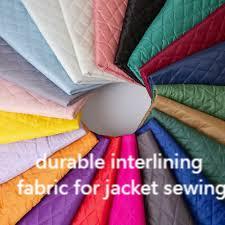Interlining-Factory Innovations: Selecting the Right Interlining for Production Efficiency

In contemporary garment production, the choice of Interlining often determines whether a piece keeps its shape and withstands repeated wear. Designers and manufacturers rely on internal layers to balance drape, structure, and comfort—selecting the right option early in the process reduces returns, improves customer satisfaction, and streamlines production. This article explores pragmatic selection strategies, production considerations, and future trends that help clothing last longer while meeting aesthetic demands.
1. Why the Hidden Layer Matters
A garment’s visible qualities—its clean lapels, stable collars, and tidy hems—depend on what lies beneath the surface. Proper internal reinforcement controls how fabrics fold, how seams bear tension, and how the finished silhouette behaves during movement. For tailored pieces, that internal element must provide enough rigidity to maintain sharp lines without feeling stiff against the body. In casual wear, the same component may need to add subtle support while preserving softness and breathability.
2. Matching Materials to Application
Not all reinforcement layers perform the same way. Nonwoven options can offer a light, flexible solution ideal for thin fabrics, while woven or knitted supports may be better for heavier outer textiles. Fusible versions speed manufacturing by eliminating extra stitching steps, but they require precise heat and pressure settings to avoid visible puckering. Selection should be driven by the face fabric’s weight, the desired hand, and production capabilities — balancing manufacturing efficiency with the feel and appearance consumers expect.
3. Production Best Practices and Quality Control
Consistency on the production floor depends on clearly documented parameters: recommended pressing temperatures, dwell times, and handling instructions reduce variability. Routine sampling and peel tests for fusible applications catch bonding issues before they propagate through a whole batch. Storage conditions also matter — humidity and temperature affect bonding agents and compressibility, so maintaining material traceability and warehouse guidelines keeps runs predictable and reduces waste.
4. Interlining-Factory’s Role in Design Support
Interlining-Factory provides technical guidance and material options that help brands translate design intent into producible garments. Collaboration during the prototyping stage ensures that the internal component complements pressing schedules and sewing sequences. Access to technical datasheets, recommended process windows, and troubleshooting support shortens development cycles and reduces costly rework. Their advisory services can be especially valuable for small brands scaling up production for the first time.
5. Durability, Care, and Consumer Experience
Longevity depends not only on material choice but also on how garments are cared for. Clear care labels that specify ironing settings, machine-wash limits, and drying instructions protect internal bonds and maintain shape. Educating customers about gentle laundering and avoiding excessive heat preserves both appearance and structure. From a product standpoint, offering replaceable or repairable design features extends usable life and aligns with growing consumer interest in sustainable purchases.
6. Sustainability and Lifecycle Thinking
Design decisions increasingly factor in end-of-life outcomes. Choosing recyclable fibers, low-impact adhesives, and minimizing mixed-material laminates eases recycling efforts later. Manufacturers can reduce waste by optimizing cutting layouts and reusing production offcuts where feasible. Designing for longer wear reduces the overall environmental footprint, since durable garments require fewer replacements over time. Lifecycle assessments that include internal components give a clearer view of overall product sustainability.
7. Innovations Shaping the Next Generation of Garments
Emerging solutions blend traditional support with added functionality—thermal control, moisture-wicking layers, or lightweight conductive pathways for smart textiles. These hybrid constructions maintain shape while adding performance attributes that meet modern consumer expectations. As textile science advances, internal layers will play an increasingly active role in comfort, temperature regulation, and even electronic integration without compromising aesthetics.
Selecting the right internal component is a strategic decision that affects manufacturing efficiency, product quality, and environmental impact. By aligning material choice with production capabilities and user care patterns, brands can create garments that look fresh longer, perform better, and contribute to more sustainable consumption. For a detailed exploration of types, applications, and technical guidance, visit https://www.interlining-factory.com/news/what-is-interlining-types-applications-and-more.html
- Art
- Crafts
- Drinks
- Fitness
- Food
- Oyunlar
- Health
- Home
- Literature
- Music
- Networking
- Finance
- Other
- Hotels
- Shopping
- Sports
- Wellness


